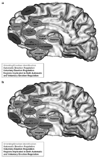A neural model of voluntary and automatic emotion regulation: implications for understanding the pathophysiology and neurodevelopment of bipolar disorder
- PMID: 18574483
- PMCID: PMC2745893
- DOI: 10.1038/mp.2008.65
A neural model of voluntary and automatic emotion regulation: implications for understanding the pathophysiology and neurodevelopment of bipolar disorder
Abstract
The ability to regulate emotions is an important part of adaptive functioning in society. Advances in cognitive and affective neuroscience and biological psychiatry have facilitated examination of neural systems that may be important for emotion regulation. In this critical review we first develop a neural model of emotion regulation that includes neural systems implicated in different voluntary and automatic emotion regulatory subprocesses. We then use this model as a theoretical framework to examine functional neural abnormalities in these neural systems that may predispose to the development of a major psychiatric disorder characterized by severe emotion dysregulation, bipolar disorder.
Figures


References
-
- Phillips ML, Drevets WC, Rauch SL, Lane R. Neurobiology of emotion perception I: the neural basis of normal emotion perception. Biol Psychiatry. 2003;54:504–514. - PubMed
-
- Hasler G, Drevets WC, Gould T, Gottesman I, Manji H. Toward constructing an endophenotype strategy for bipolar disorders. Biol Psychiatry. 2005;60:93–105. - PubMed
-
- Phillips ML, Frank E. Redefining bipolar disorder: toward DSM-V. Am J Psychiatry. 2006;163:1135–1136. - PubMed
-
- Charney DS, Barlow DH, Botteron K, Cohen JD, Goldman D, Gur RE, et al. Neuroscience research agenda to guided development of a pathophysiologically based classification system. In: Kupfer DJ, First MB, Regier DA, editors. A Research Agenda for DSM-V. Washington, DC: American Psychiatric Association; 2002. pp. 31–83.
-
- Bowden CL. Strategies to reduce misdiagnosis of bipolar depression. Psychiatr Serv. 2001;52:51–55. - PubMed

